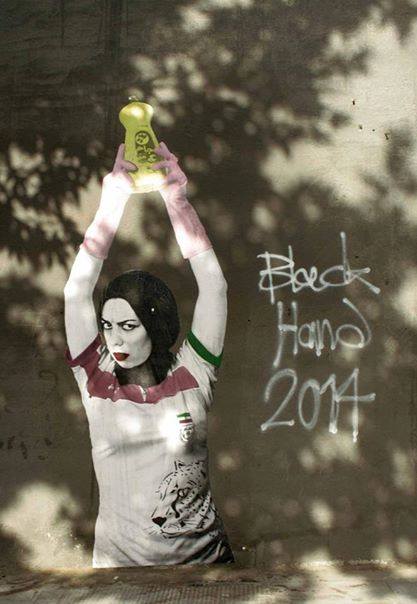Underground Graffiti
by Yaghoub Yadali and translated by Parvaneh Torkamani / August 22, 2014 / No comments
A dissident Iranian street artist — or artists — uses graffiti to create a political stir.

Black Hand depicts the Iranian government's oppression of women in sports. Photo: Facebook.
Painting on the wall, or graffiti, is the art of designing shapes, forms, letters, signs, images, symbols, patterns, and words in any public place where one can paint, draw, carve, or write. But in Iran, artistic expression can have a double use: formal or informal, legal or underground. The things that distinguish the two forms of artistic expression are censorship and religious, official, and social limitations.

- “Enemy…terrorism…nuclear bomb…war.” These words are often used by American media to describe Iran. The image the media presents is often hazy, incomplete, and distorted. The political and military aspects of my country are covered mainly in a negative light.
- In Under Eastern Eyes (I have adopted the name from the novel Under Western Eyes by Joseph Conrad), I will write about those topics which American media either cannot or does not want to talk about. The emphasis will be on social and cultural aspects of Iran although, out of necessity, I will talk about politics, despite my despair.

- Yaghoub Yadali, born in 1970, is a writer and television director. His first work of fiction, the short-story collection Sketches in the Garden, was published in 1997. It was followed in 2001 by Probability of Merriment and Mooning, which was named book of the year by the Writers and Critics Award. His first novel, The Rituals of Restlessness, won the 2004 Golshiri Foundation Award for the best novel of the year and was named as one of the ten best novels of the decade by the Press Critics Award. He has also published many articles and reviews of literature and cinema in newspapers and magazines in Iran.
State-sponsored graffiti, usually depicting martyrs and revolutionary figures from Iranian history, has been seen in Iran for many years. Fifteen years ago, citizen graffiti began to attract the attention of passersby on the streets of Tehran. At first, music and rap were the subjects of the artwork. But later the subjects varied. Citizen graffiti spread to other cities beyond Tehran. Sometimes it was used as a form of protest, leading to a repetitious game of cat and mouse between graffiti artists and city officials. Both parties were ready and alert, with paint and brush and spray. One side was for creating art, and one was for erasing it.
These days a group named “Black Hand” is attracting attention with its graffiti. Black Hand is anonymous, and all we know is that their group is made up of one or a few young women. Their art mostly addresses social issues, and they protest the government’s restrictions in very creative ways. Black Hand covers a diverse range of subject matter, including the Brazil World Cup, Freudian theories, the war in Gaza, and Iranian-U.S. relations. Black Hand delicately mixes dissident statements with artistic techniques, and sometimes it takes a moment to understand the meaning of the graffiti.
In one of Black Hand’s most beautiful and controversial works, a woman wears Iran’s national football team uniform and rubber kitchen gloves. She holds World Cup brand dishwashing detergent above her head like a soccer trophy. In Iran, women are allowed a very small role in sports, and they are not allowed to go to the stadium to watch athletic events. In another example of Black Hand’s graffiti, the words: “I am suspicious of these bricks,” are written on a red brick wall. Iranian authorities have taken to painting red bricks on white walls, both to hide cement and to make graffiti less visible. In another work “I am a trustworthy citizen,” is written upside-down next to the so-called trustworthy citizen! Black Hand has also spray-painted the URL to a YouTube video in which a military commander acknowledges interfering with the controversial 2009 presidential election.
This art demonstrates the creativity of the young artist(s), risking it all to share the sentiments of their generation in Iran’s closed and heavily controlled environment. They may pay for it with their own lives.




